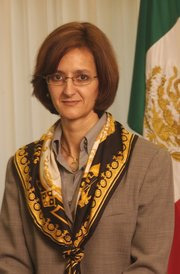
|  |  |  News Around the Republic of Mexico | October 2008 News Around the Republic of Mexico | October 2008  
Mexico Expands Eligibility for Bracero Payment
 Susan Ferriss - SacBee.com Susan Ferriss - SacBee.com
go to original


| | Alejandra Bologna, consul general in Sacramento's Mexican Consulate | | |
After kicking off a wage repayment program for World War II-era braceros Thursday, Mexico also is now accepting compensation requests from any former bracero who participated in the 22-year guest worker program and lives in the United States.

Alejandra Bologna, consul general in Sacramento's Mexican Consulate, confirmed that Mexico has expanded eligibility to apply by Jan. 5 for a onetime $3,500 payment to any bracero – or his survivor – who can prove the worker was contracted here sometime between 1942 and 1964.

An earlier requirement limited eligibility for anyone who now lives outside Mexico to the work done between 1942 and 1946.

The payments are a response to complaints that braceros during World War II and subsequent years had 10 percent of their wages garnished and put in a savings fund in Mexico that was not returned to most of the workers.

To settle this dispute, Mexico agreed to pay any bracero if he or a survivor could prove work history and file a claim in Mexico. For former braceros in the United States, that meant traveling to Mexico.

To settle a separate lawsuit filed in the United States, Mexico agreed recently to take requests from braceros at Mexican consulates in the United States.

Luis Magaña, who heads the Stockton-based 5,000-member Northern California Braceros Association, said the expansion of the program will now allow his infirm father, who cannot travel, to apply.

"We told those who were able to travel to pack their suitcases. We were going to charter some buses to go to the border for them to apply in Mexicali, but now we won't have to," he said.

Magaña's father, Luciano, 85, arrived in the United States in 1943 but no longer has documents proving he worked during World War II. His Social Security records, however, show he also worked as a bracero during the 1950s and early 1960s, Magaña said.

Magaña noted that the vast majority of an estimated 3 million braceros entered the United States during the 1950s and early 1960s. Most of them worked in California, where agribusiness was growing dramatically.

Most braceros returned to Mexico but a good number became legal residents through marriage or employer sponsors, settled and raised families here.

Bologna said her office has received dozens of inquiries about the payment program in the last few days.

An original work contract, a bracero ID card or Social Security records are among documents that can support a claim. A widow who is a Mexican national can file a claim, or a child can if both parents are deceased.

If the child is U.S.-born, he or she must obtain Mexican nationality, which can be done through consulates based on a parent's Mexican citizenship, Bologna said.

"At least half the people are going to have problems with documentation," Magaña said. "Right now we're in a race against the clock to help them find documents before Jan. 5."

sferriss@sacbee.com |

 |
|  |



